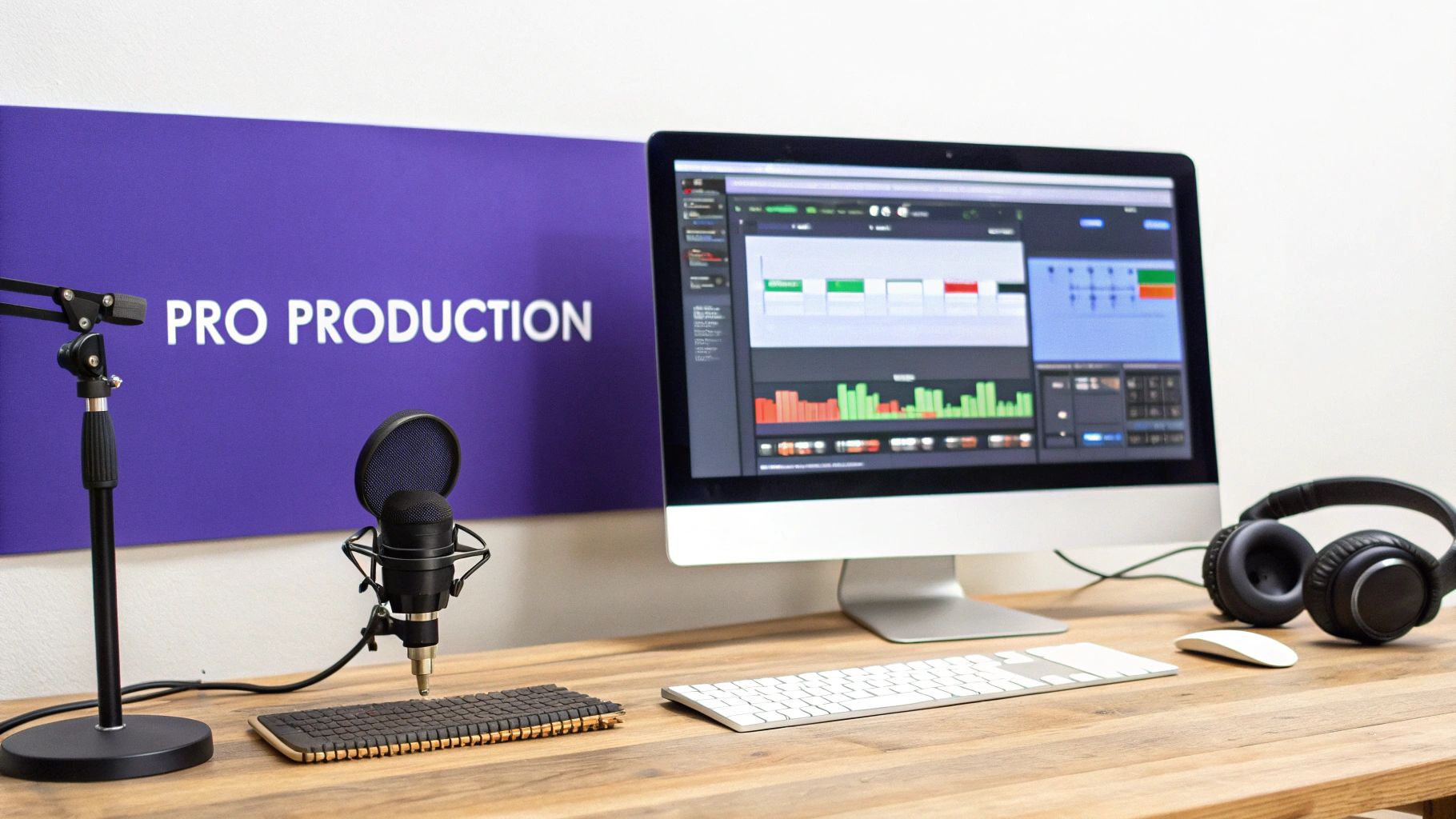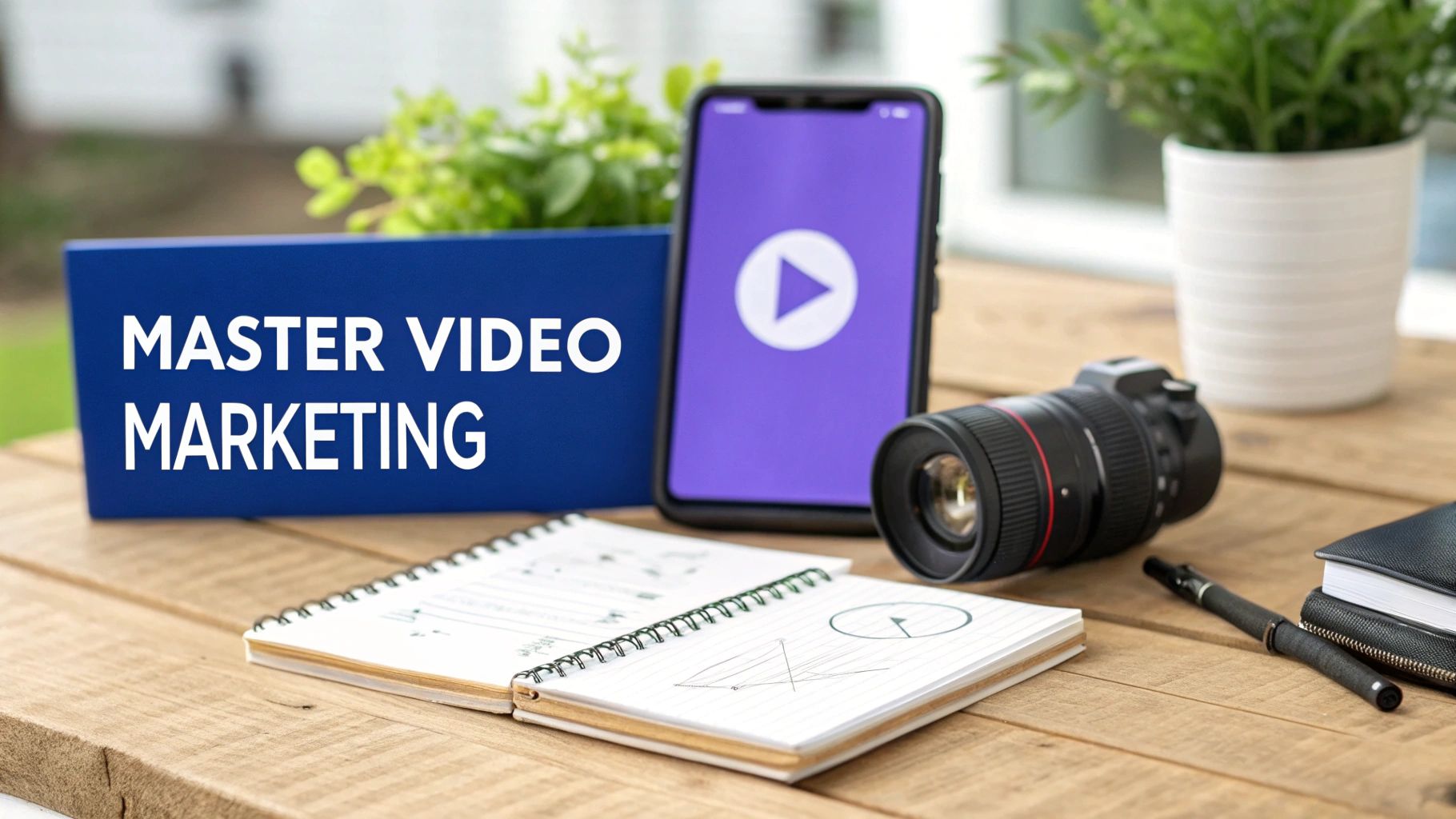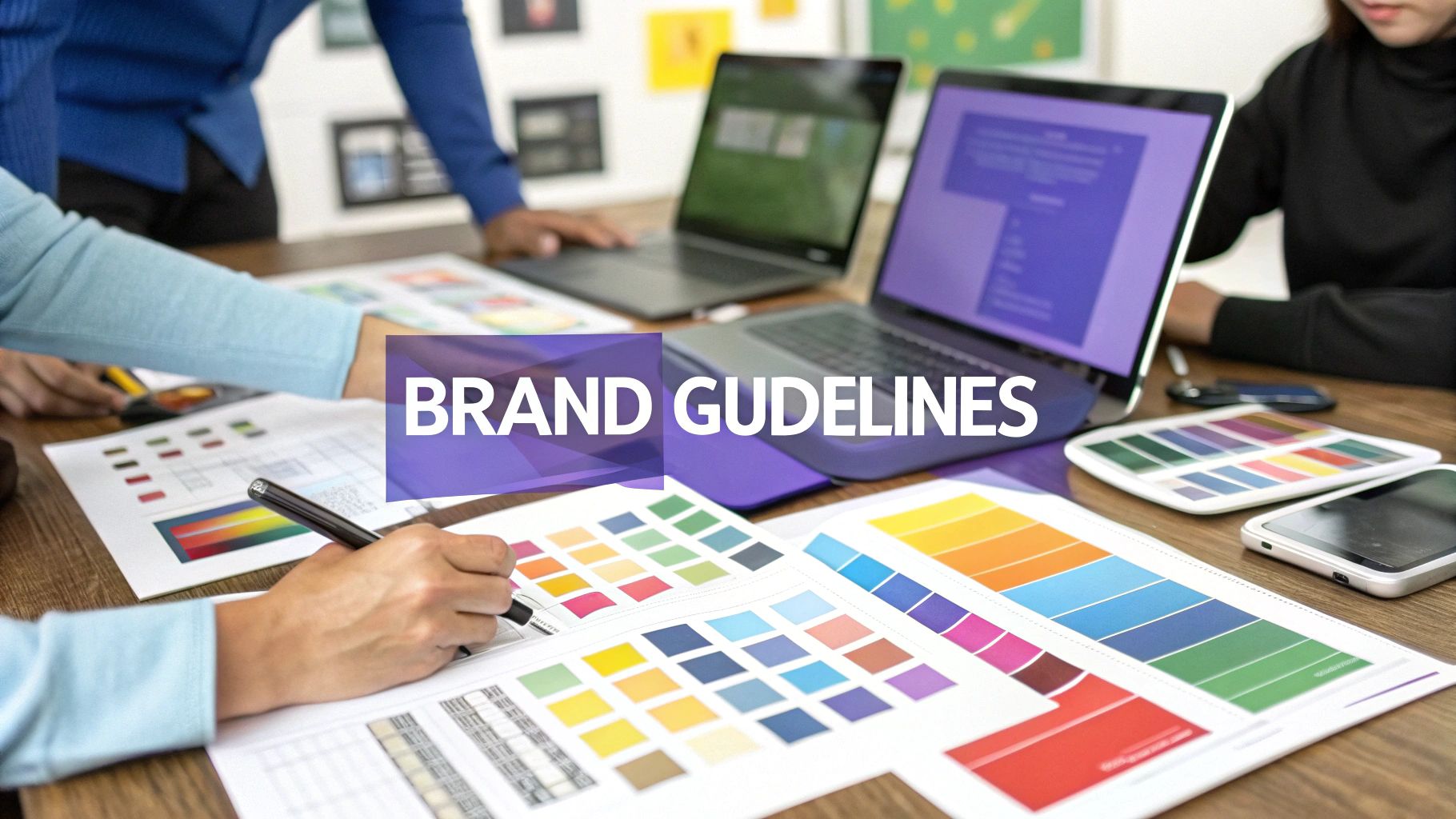When we talk about video marketing for social media, we're really talking about using video—both short clips and longer-form content—to grab attention and hit business goals on platforms like Instagram, TikTok, and YouTube. Let's cut to the chase: it's the single most powerful way to tell your story, inject personality into your brand, and actually connect with people in today's crowded feeds.
Why Video Absolutely Crushes It on Social Media

Let's be perfectly clear—video isn't just another option for your social media calendar; it's the main event. Static images and plain text posts just can't hold a candle to the dynamic, multi-sensory experience a video delivers. But what makes it so magnetic? It really boils down to human psychology.
Our brains are wired to pay attention to visual information, especially things that move. Video pulls together movement, sound, and story, making it incredibly good at getting a point (and an emotion) across quickly. That efficiency is everything on social media, where you have mere seconds to stop someone from scrolling past.
The Science of Stopping the Scroll
Picture your social media feed as a busy city street. A static image is a billboard—you might notice it, but you're probably going to keep walking. A video, on the other hand, is like a street performer juggling fire. You can't help but stop and watch, even for just a second. This built-in ability to hijack attention is exactly why social media algorithms tend to push video content, giving it a much better shot at organic reach.
And for businesses, this translates directly into results you can measure:
- Sky-High Engagement: Videos rack up more likes, comments, and shares because they tap into our emotions in a way other content can't.
- Sticky Brand Recall: When you combine sound and visuals, your message sticks. People are far more likely to remember your brand after watching a video than after scanning a text post.
- Real Connection: Seeing human faces and hearing real voices builds trust and forges a personal link between your brand and your audience.
Video marketing isn't just a fleeting trend. It's a fundamental change in how we communicate online. It lets brands stop broadcasting messages at people and start creating shared experiences with their community.
The momentum here is undeniable. In fact, projections show that by 2025, video is on track to make up a staggering 82% of all global internet traffic. This isn't a fluke; it's driven by fast internet speeds, the explosion of platforms like TikTok and YouTube Shorts, and a clear preference for content that's immersive and easy to consume. For any brand that wants to stay in the game, the data is sending a very clear message: a smart approach to video marketing for social media is no longer a "nice-to-have." You can explore more about these video consumption trends and what they mean for marketers trying to keep up.
Building Your Strategic Video Marketing Blueprint

A great video strategy doesn't just happen the moment you hit record. It starts way before that, with a solid, intentional plan. If you don't have a blueprint, you're basically just making videos at random and hoping something sticks. A strategic approach, on the other hand, turns those random acts of content into a goal-driven machine.
Think of it like building a house. You wouldn't just start nailing boards together without a set of architectural plans. Your video strategy is that plan. It ensures every single video you create has a real purpose and pushes you closer to your main objective.
Define What Success Looks Like
Before you even think about a single video idea, you have to get crystal clear on your goal. What, exactly, do you want your videos to accomplish? This is the most important first step, because it shapes every other decision you'll make down the line.
Your goals should line up with the different stages of the marketing funnel. Are you trying to get your brand in front of new faces, or are you trying to nudge warm leads toward a purchase?
- Awareness: The main goal here is to reach new audiences and introduce them to who you are. Success is all about metrics like reach, impressions, and video views.
- Consideration: At this stage, you're trying to build interest and show potential customers why your solution is the one they need. You’ll be tracking things like click-through rates and how much website traffic your videos are driving.
- Decision: This is the money-making stage where you drive conversions. Success is measured by leads generated, product trials started, or direct sales that came from your video content.
Pick one primary goal to begin with. A focused strategy is always more powerful than trying to do everything at once. When you're putting together your plan, looking at effective Small Business Video Marketing Strategies can give you some great, realistic ideas to work with.
Understand Your Audience Deeply
Once you've got your goal locked in, it's time to figure out who you're talking to. Making videos for "everyone" is a surefire way to connect with no one. You need a sharp, detailed picture of your ideal viewer.
Go beyond the basic demographics like age and location. You need to dig into their psychographics to really get what makes them tick—their motivations, their problems, and where they hang out online.
Your audience isn't just a demographic; they are a community with a shared culture, language, and set of problems. Your videos must speak their language and solve their problems to earn their attention.
Answering these questions will help you create content that actually hits home:
- What are their biggest pain points or dreams that your brand can help with?
- What kind of humor, tone, and style do they actually like?
- Which social media platforms are they scrolling through when they discover new brands or products?
Brainstorm Content and Plan Your Calendar
Now that you have your goals and audience nailed down, you can finally start brainstorming video ideas that serve both. It helps to map these ideas directly to your marketing funnel. For instance, an awareness video might be a quick, funny clip, while a decision-stage video could be a more in-depth customer testimonial.
A content calendar is your best friend for staying consistent. It doesn't have to be some overly complicated system; a simple spreadsheet works perfectly. Try to plan your videos at least a month ahead so you're not constantly scrambling for what to post next. This creates a steady flow of great content, which is the secret to building a loyal following through video marketing for social media.
Matching Your Video to the Right Social Platform
One of the most common mistakes I see brands make is posting the same exact video everywhere. It’s like wearing a tuxedo to a backyard barbecue—sure, you might look sharp, but you’re completely out of place. Every social media platform has its own vibe, its own algorithm, and its own audience expectations.
To really connect, your video has to feel like it belongs there. This isn't just about changing the aspect ratio; it's about tailoring the tone, style, and length to what users on that platform actually want to see. A video that absolutely kills it on TikTok can easily be a dud on LinkedIn if you just copy and paste it without a second thought.
Adapting to Platform-Specific Cultures
Think of each platform as a different type of social event. LinkedIn is a professional networking conference. Instagram is a trendy art gallery. TikTok is a flash mob, and YouTube is a community film festival. Your content needs to dress for the occasion to make a real impact.
TikTok and Instagram Reels: These platforms are all about high-energy, fast-paced entertainment. Users are scrolling for quick, catchy videos, often set to trending audio or following a specific challenge. Your video marketing for social media here should be fun, authentic, and ready to jump on trends as they happen.
YouTube: This is the home of deep dives and long-form content. People come to YouTube to learn something new, be thoroughly entertained, or follow creators they genuinely connect with. It’s the perfect spot for detailed tutorials, behind-the-scenes vlogs, customer stories, or educational series that build your authority over time.
LinkedIn: The atmosphere here is buttoned-up and professional. Videos should deliver real value through industry insights, career advice, company news, or expert interviews. A polished look and a clear, benefit-driven message are what earn respect and engagement from this business-focused audience.
Facebook: This platform is a true jack-of-all-trades, supporting everything from quick Reels and Stories to longer live streams and in-feed videos. It’s fantastic for community-building content like live Q&As, behind-the-scenes peeks, and customer testimonials that connect with a wide range of people.
The most successful brands don't just post videos on a platform; they create videos for the platform. This subtle shift in mindset from distribution to adaptation is what separates content that gets ignored from content that gets shared.
The infographic below breaks down the key differences between creating short-form and long-form videos for social media.

As you can see, short-form video is a powerhouse for grabbing initial engagement with less production effort. But when you want to hold your audience's attention for longer and build a deeper connection, long-form content is where it's at.
A Quick Guide to Platform Video Specs
Getting the creative style right is half the battle. The other half is nailing the technical details. Each platform has its own preferences, and getting them right makes your video look professional and helps the algorithm show it to more people.
To make this easier, here's a quick reference table.
Social Media Video Content Guide
| Platform | Optimal Video Length | Best Format/Style | Primary Goal |
|---|---|---|---|
| TikTok | 15-60 seconds | Vertical (9:16). Trendy, raw, music-driven. | Virality & Brand Awareness |
| Instagram Reels | 15-90 seconds | Vertical (9:16). Polished, aesthetic, creative. | Engagement & Discovery |
| YouTube | 2-10+ minutes | Horizontal (16:9). Educational, storytelling, in-depth. | Authority & Education |
| YouTube Shorts | Under 60 seconds | Vertical (9:16). Quick tips, entertaining clips. | Reach & Channel Growth |
| 30 seconds - 5 minutes | Horizontal or Square. Professional, insightful, news. | Lead Gen & Networking | |
| 1-3 minutes | Vertical, Square, or Horizontal. Community-focused, stories. | Community & Consideration |
This table is a great starting point, but always be ready to test and see what works best for your specific audience.
Optimizing Technical Specs for Each Channel
Beyond the creative style, you have to get the technical specs right. These details can make or break how your video is perceived and promoted by each network's algorithm.
Vertical vs. Horizontal Video There's no debate here: vertical video (9:16 aspect ratio) is the undisputed king on mobile-first platforms like TikTok, Instagram Reels, and YouTube Shorts. It fills the entire phone screen, creating a much more immersive experience. If you post a horizontal video there, you're stuck with those awkward black bars and a tiny viewing window. Nobody wants that.
Horizontal video (16:9 aspect ratio) still has its place, primarily for YouTube's traditional long-form content. It also works well on LinkedIn and in Facebook feeds, especially for users on a desktop.
Video Length Best Practices The data is clear: video is essential. By 2025, an incredible 89% of businesses will be using video in their marketing, with short-form content often delivering the highest ROI. But "short" means different things on different platforms. For instance, the latest social media video stats show that clips under 15 seconds perform well on Instagram and X (formerly Twitter), while TikTok's sweet spot is a bit longer at 15-60 seconds. YouTube audiences, on the other hand, are often happy to settle in for videos well over a minute long.
Aligning your video's format and length with the platform is a huge piece of the puzzle. But it's just as important to focus your energy on the right channels in the first place. Knowing the top 10 social media platforms dominating 2025 ensures you're meeting your audience where they already are. When you match your content to the platform's culture and its technical specs, you give your videos the best possible chance to succeed.
Creating Social Media Videos That People Actually Watch

Knowing which platform to use is half the battle. Knowing what to post is how you actually get people to stop scrolling. Effective video marketing for social media isn't about theory; it's about building a practical toolkit of video formats that connect with real people. A varied content mix is your best bet for keeping the feed interesting and speaking to different people at different points in their journey with your brand.
Think of your video formats like tools in a workshop. You wouldn't grab a hammer to saw a piece of wood. In the same way, you wouldn't use a slick, polished product ad when your goal is to build genuine community trust. The trick is to match the video format to the job at hand, whether that's getting your name out there, making a sale, or turning customers into loyal fans.
Authentic Behind-The-Scenes Content
One of the best ways to make your brand feel human is simply to pull back the curtain. Behind-the-scenes (BTS) content breaks down that corporate wall and reveals the real people and processes that make everything happen. This raw, less-polished approach builds an incredible amount of trust and makes you far more relatable.
This kind of video feels right at home on platforms like Instagram Stories and TikTok, where authenticity is the most valuable currency. Show your team brainstorming, give a "day in the life" tour, or even share a funny blooper from a shoot. These are the moments that make your brand feel less like a faceless company and more like a group of people your audience would want to know.
The Power of Product Demos
When you're ready to show off what you've got, nothing works better than a clear, straightforward product demo. This is your chance to go beyond a boring list of features and focus on the real-world benefits. A great product demo doesn't just explain what your product does—it shows people exactly how it will solve their problem or make their life easier.
These videos are pure gold for platforms like YouTube, where people are actively searching for answers, and they're essential for your own product pages. The key is to keep them focused and benefit-driven. Instead of listing every single feature, just show the product in action, solving a common headache for your ideal customer.
The most effective video content doesn't just interrupt a user's feed; it adds genuine value to it. Whether it educates, entertains, or inspires, the goal is to leave the viewer feeling like their time was well spent.
When thinking about specific formats, exploring how to use Instagram Reels for business can unlock powerful ways to create short-form content that really connects. A solid bank of video ideas is what keeps your strategy moving and your audience tuning in.
User-Generated Content and Testimonials
Sometimes, the most convincing voice isn't yours—it's your customers'. User-generated content (UGC) and video testimonials act as powerful social proof, putting the spotlight on real people who genuinely love what you do. This is miles more persuasive than any ad you could create because it comes from a place of pure, unscripted enthusiasm.
Encourage your customers to share their stories by running a contest or creating a unique branded hashtag. When you reshare this content, you're not just filling your schedule; you're building a powerful sense of community. When potential buyers see videos from people just like them, it instantly lowers their hesitation and builds a foundation of trust.
It's no surprise that social media videos are the second most popular content type, with 69% of marketers using them. This is part of a larger trend where 95% of brands now see video as a must-have marketing tool, using everything from testimonials to demos to connect with their audience.
Other High-Impact Video Formats
To keep your content strategy from getting stale, try mixing in some of these other effective video types. Each one has a unique job to do in your overall social media plan.
- Expert Interviews: Position your brand as a go-to resource by hosting interviews with other leaders in your field. This lets you borrow their credibility and gives your audience incredible value.
- Animated Explainers: Got a complex idea or product? Animated videos are perfect for breaking down tough concepts into simple, visually interesting stories that are easy to digest.
- Live Q&A Sessions: There's no better way to build a direct connection than through real-time interaction. Going live on Facebook, Instagram, or LinkedIn creates an authentic, two-way conversation with your followers.
Figuring out the right content mix is always a work in progress. If you're feeling stuck, check out our guide on social media content ideas to get the creative juices flowing for your next video.
Of course. Here is the rewritten section, crafted to sound completely human-written and natural, following the provided style guide and requirements.
Measuring What Matters in Your Video Marketing
So, you've created a fantastic video. That's a great start, but it's only half the battle. If you want to build a truly successful strategy for video marketing for social media, you have to know what's working, what's falling flat, and why. It means resisting the temptation of vanity metrics and digging into the data that shows you what’s really happening.
Views are nice, but they don’t tell the whole story. A video with one million views that everyone clicked away from after three seconds is a failure, not a win. To turn your video efforts from an expensive hobby into a real growth engine, you need to focus on the numbers that signal genuine audience interest and, ultimately, business impact.
Think of it like this: a high view count is like having a packed storefront. But if nobody buys anything or even stops to browse, that crowd is just noise. Real success comes from understanding what holds attention and drives people to act.
Beyond Views to Real Engagement
To get a clear picture of your video's performance, you need to look at metrics that show how people are actually interacting with your content. These are the numbers that tell you if your message is landing and if your story is compelling enough to stop the scroll.
This is where you can truly diagnose the health of your content. I always tell people to start by focusing on two key areas:
- Audience Retention: This is, without a doubt, one of the most important video metrics out there. It shows you the exact percentage of your audience that is still watching at every single second of your video. A high retention rate means you’ve created something compelling. A big, sudden drop-off? That’s your audience telling you exactly where they got bored.
- Watch Time: This metric is simple but powerful—it’s the total number of minutes people have spent watching your video. Social media algorithms absolutely love high watch times. Why? Because it tells them you’re creating quality content that keeps people on their platform longer, which often means they'll show your video to even more users.
Seriously, analyzing your audience retention graph is like getting direct, unfiltered feedback. You can pinpoint the moments that hit home and the parts that made people leave, which is invaluable for making your next video even better.
Tracking the right metrics is the difference between guessing and knowing. It transforms your video strategy from a creative gamble into a data-driven system for predictable growth.
Measuring Bottom-Line Impact
While engagement is critical, you also have to connect your video efforts to real business outcomes. This is how you prove the value of your video marketing and justify the time and money you put into it. The goal is to see exactly how your videos influence customer behavior and push them through your marketing funnel.
Start by tracking these conversion-focused metrics:
- Click-Through Rate (CTR): If your video has a call-to-action (CTA) like "Visit our website" or "Shop now," the CTR tells you what percentage of viewers actually clicked it. A low CTR could mean your CTA wasn't clear, compelling enough, or placed at the right moment.
- Conversion Rate: This is the ultimate measure of success. It tracks how many viewers took the specific action you wanted them to take after watching—signing up for a newsletter, downloading a guide, or even making a purchase. This metric directly ties your video to lead generation or revenue.
Keeping an eye on these numbers helps you understand the real ROI of your video content. To keep it all straight and present your findings clearly, using a comprehensive social media analytics report template can give you a clean view of how your videos are performing against your core business goals. By focusing on these impactful metrics, you can stop guessing what works and start making decisions that consistently drive better results.
Of course. Here is the rewritten section, crafted to sound completely human-written and match the provided style examples.
Common Questions About Social Media Video Marketing
Jumping into video for social media feels like a big commitment, right? It's easy to get bogged down by questions about budgets, fancy gear, and ever-changing trends before you even hit record. Let's tackle these common roadblocks head-on with some straight-up, practical answers so you can start creating with confidence.
These questions are totally normal. The trick is to not let them paralyze you and miss out on the incredible power of video.
How Much Should I Budget for Social Media Video?
There's really no one-size-fits-all answer here. A video budget can be anything from practically zero—using just your phone and a free app—all the way up to thousands for a huge campaign. It all comes down to what you're trying to achieve.
For instance, if your goal is building brand awareness on TikTok, a low-fi, authentic video often works best and costs next to nothing. But if you’re creating a slick product demo for a LinkedIn audience, you'll probably want to set aside more cash for better gear and professional editing.
The smartest way to go about it is to start small. See what works, measure your return on investment (ROI), and then double down on the video styles and platforms that actually bring in results.
What Equipment Do I Absolutely Need to Start?
You can get going with just three things. Seriously, don't let the idea that you need a full-blown studio hold you back.
- A modern smartphone: Honestly, the camera in your pocket is more than powerful enough for great-looking social media videos.
- Good lighting: This one is non-negotiable. It can be as simple as a basic ring light or even just setting yourself up in front of a sunny window. The difference is night and day.
- Clear audio: Bad audio is the fastest way to get someone to scroll past your content. Even the microphone on your standard earbuds is a huge step up from your phone’s built-in one.
On platforms like TikTok and Instagram Reels, authenticity almost always wins over high production value. Focus on getting your message across clearly and providing real value. You can always upgrade your setup later.
How Do I Keep Up with Constantly Changing Trends?
Look, trying to hop on every single trend is a one-way ticket to burnout. A much better, more sustainable approach is to simply be an active user of the platforms you're on.
Just spend 15-20 minutes a day scrolling your target channels—the "For You" page on TikTok or the Reels tab on Instagram. Notice the sounds, formats, or challenges that keep popping up.
Make a point to follow other creators and brands in your industry. See what’s clicking with their audience, because it's likely your audience too. The idea isn't to be a copycat, but to understand the "language" of the platform so you can adapt what's current to your own brand voice. That's how you make content that feels fresh and native to the feed.
Ready to take control of your video content and streamline your entire social media workflow? PostSyncer provides an all-in-one platform to plan, schedule, and analyze your video performance across every network. Start your 7-day free trial today and see how our AI-powered tools can simplify your process and amplify your results.















